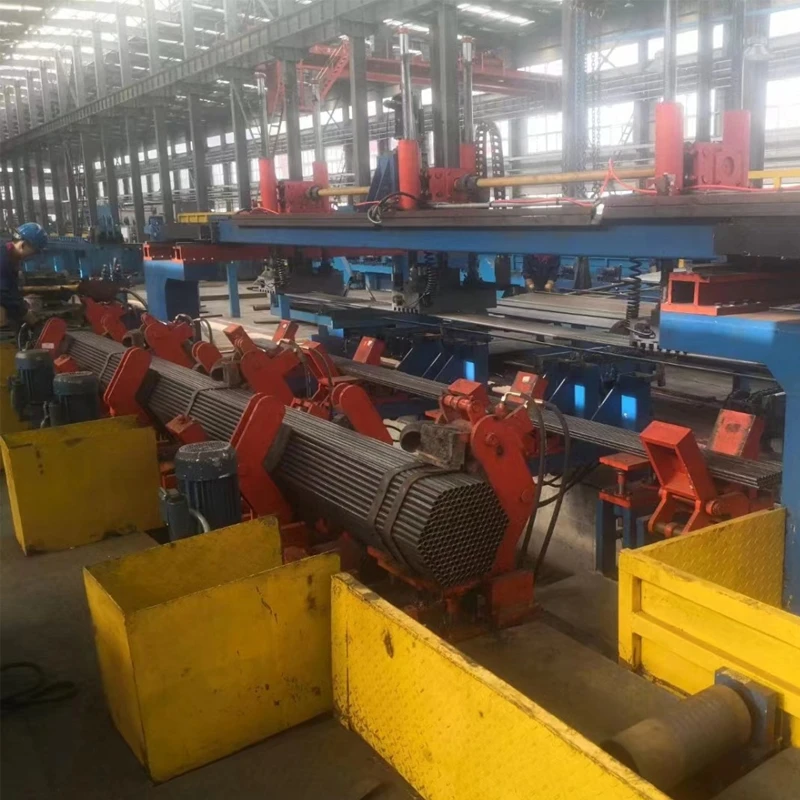galvanized pipe making machine
The Evolution and Importance of Galvanized Pipe Making Machines
In modern construction and plumbing, galvanized pipes have become an essential component due to their durability and resistance to corrosion. The process of producing these pipes relies heavily on specialized machinery, known as galvanized pipe making machines. These machines represent a significant advancement in technology, enabling the efficient production of high-quality galvanized pipes that meet the growing demands of various industries.
Understanding Galvanization
Galvanization is the process of applying a protective zinc coating to steel or iron to prevent rusting. This method has been widely adopted due to the increasing need for reliable and long-lasting materials in construction, plumbing, and numerous industrial applications. The galvanized layer acts as a sacrificial barrier; even if the coating is scratched, the zinc will corrode before the underlying metal, thereby extending the lifespan of the pipes.
The Role of Pipe Making Machines
Galvanized pipe making machines are essential in the production process of galvanized pipes. These machines not only facilitate the forming of pipes but also ensure that the process adheres to strict quality standards. The production of galvanized pipes involves several key steps slitting, forming, welding, and galvanizing.
1. Slitting Process The raw material, usually in the form of strips of steel, is fed into a slitting machine. This machine cuts the steel strips into smaller widths suitable for pipe production. Precision during this phase is crucial, as any discrepancies can lead to the production of faulty pipes.
2. Forming the Pipe Once the strips are cut, the next step is to form them into a tubular shape. The pipe forming machine takes the slit steel and rolls it into a cylinder. This process often utilizes roll forming technology, where multiple rollers gradually shape the steel strip into its final pipe configuration.
galvanized pipe making machine

3. Welding The formed pipe edges are then joined using welding machines. The welding process can vary, with techniques such as Electric Resistance Welding (ERW) being commonly used. This method is efficient and ensures strong, leak-proof connections that are crucial for any plumbing application.
4. Galvanizing After welding, the pipes are coated with zinc through hot-dip galvanizing or electro-galvanizing methods. In hot-dip galvanizing, pipes are immersed in molten zinc, providing a thick and robust coating. This step is vital for enhancing the corrosion resistance of the pipes, thereby increasing their durability.
Advantages of Modern Machines
Modern galvanized pipe making machines boast advanced features that significantly improve productivity and efficiency. Automation has played a crucial role in this evolution. Automated systems utilize computer controls to monitor and adjust every stage of production, minimizing human error and maximizing output. This not only speeds up the manufacturing process but also ensures consistent product quality.
Furthermore, advances in machine design have led to more energy-efficient processes. Modern machines are designed to utilize less energy while maintaining high performance, making them environmentally friendly. The reduced waste during production processes also contributes to a lower environmental impact.
Conclusion
In conclusion, galvanized pipe making machines are pivotal in producing the high-quality pipes that support various sectors, from construction to agriculture. As technology continues to advance, the efficiency and capabilities of these machines will undoubtedly improve, allowing manufacturers to meet the ever-growing demand for durable, corrosion-resistant pipes. The evolution of these machines reflects broader trends in industrial manufacturing, highlighting a commitment to quality, efficiency, and sustainability in an increasingly competitive market. As we move forward, the importance of galvanized pipes and the machines that produce them will only continue to escalate, ensuring a robust infrastructure for future generations.
-
High Frequency Straight Seam Welded Pipe Production Line-BzZhou Xinghua Machinery Equipment Manufacturing Co., LTD.|line pipe steel&welded gas pipeNewsJul.30,2025
-
High Frequency Straight Seam Welded Pipe Production Line-BzZhou Xinghua Machinery Equipment Manufacturing Co., LTD.|High Precision&Automated SolutionsNewsJul.30,2025
-
High Frequency Straight Seam Welded Pipe Production Line - BzZhou Xinghua Machinery Equipment Manufacturing Co., Ltd.NewsJul.30,2025
-
High Frequency Straight Seam Welded Pipe Production Line-BzZhou Xinghua Machinery Equipment Manufacturing Co., LTD.|Precision Welding, High EfficiencyNewsJul.30,2025
-
High Frequency Straight Seam Welded Pipe Production Line|BzZhou Xinghua|Precision Welding&EfficiencyNewsJul.30,2025
-
High Frequency Straight Seam Welded Pipe Production Line - BzZhou Xinghua|Precision Engineering&EfficiencyNewsJul.30,2025


